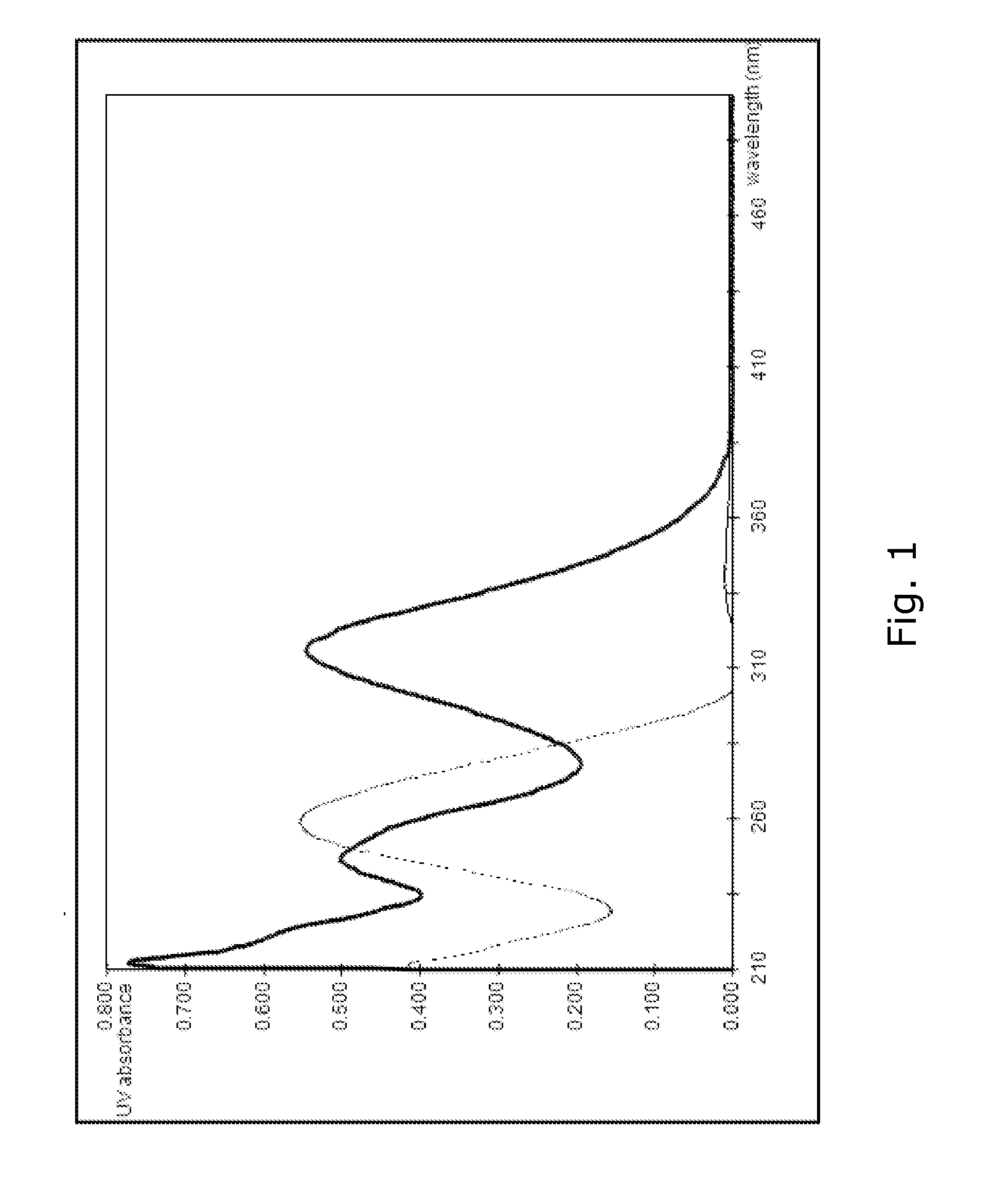Novel polymeric photoinitiators and photoinitiator monomers
a polymer and photoinitiator technology, applied in the field of polymer photoinitiators, can solve the problems of low molecular weight substances, reduced photoinitiator weight fraction of molecule, and toxic to plants and animals, and achieve the effect of improving medical safety
- Summary
- Abstract
- Description
- Claims
- Application Information
AI Technical Summary
Benefits of technology
Problems solved by technology
Method used
Image
Examples
preparatory example 1
4-{3-[BIS(2-HYDROXYETHYL)AMINO]PROPOXY}BENZOPHENONE
[0563]
Relevant Literature
[0564]J. Med. Chem. 2001, 3810-3820; J. Med. Chem. 1998, 3976-3986; J. Med. Chem. 1989, 105-118.
[0565]Small Scale:
[0566]A 1000 mL three-neck flask was charged with 4-hydroxybenzophenone (50.00 g; 252.2 mmol), 1-bromo-3-chloropropane (79.41 g; 504.4 mmol) and 2-butanone (500 mL). After flushing with nitrogen, anhydrous potassium carbonate (104.6 g; 756.5 mmol) was added and the reaction mixture was stirred at reflux for 24 h. Full consumption of the starting 4-hydroxybenzophenone was confirmed by TLC. The reaction mixture was filtered, the filtrate evaporated, the oily residue dissolved in dichloromethane (300 mL) and extracted with water (3×100 mL). The organic phase was separated, evaporated, and the unreacted 1-bromo-3-chloropropane was removed by heating to 70° C. in vacuo. The residue was dissolved in 2-butanone (500 mL) and sodium iodide (45.36 g; 302.6 mmol) was added. The reaction mixture was refluxed...
preparatory example 2
4-{3-[BIS(2-HYDROXYETHYL)AMINO]PROPOXY}-1-CHLORO-9H-THIOXANTHEN-9-ONE
[0575]
[0576]Small Scale:
[0577]A 500 mL flask was charged with the sodium salt of 1-chloro-4-hydroxy-9H-thioxanthen-9-one (28.5 g; 0.100 mol), 1-bromo-3-chloropropane (17.4 g; 0.111 mol) and isopropyl alcohol (280 mL). The turbid reaction mixture was refluxed for 24 h. The hot solution was diluted with isopropyl alcohol (130 mL), drowned out in water (1400 mL) and the resulting suspension was extracted with dichloromethane (3×250 mL). The organic phase was separated, dried (MgSO4), filtered and solvent removed in vacuo to give 1-chloro-4-(3-chloropropoxy)-9H-thioxanthen-9-one (24.4 g; 72% yield).
[0578]1H-NMR (400 MHz, CDCl3): 8.39 (ddd, J=8.1, 1.5, 0.6 Hz, 1H), 7.54 (m, 1H), 7.48 (ddd, J=8.1, 1.4, 0.6 Hz), 7.41 (m, 1H), 7.33 (d, J=8.6 Hz, 1H), 6.92 (d, J=8.6 Hz, 1H), 4.23 (t, J=5.8 Hz, 2H), 3.83 (t, J=6.3 Hz, 2H), 2.32 (apparent quintet, J=6.0 Hz, 2H).
[0579]The crude product from the previous step (26.44 g; 77.94 mm...
preparatory example 3
{4-[BIS(2-HYDROXYETHYL)AMINO]PHENYL}(PHENYL)METHANONE
[0586]
Relevant Literature
[0587]J. Phys. Org. Chem. 2001, 14, 247-255; J. Med. Chem. 1991, 34, 1552-1560.
[0588]A 100 mL two-neck flask was charged with 4-fluorobenzophenone (15.0 g; 74.9 mmol) and diethanolamine (55.1 g; 524 mmol). The flask was flushed with nitrogen, fitted with a reflux condenser and heated to 155° C. for 48 h under a gentle stream of nitrogen. Complete conversion of the starting 4-fluorobenzophenone was confirmed by TLC. After cooling to ambient temperature, the dark viscous reaction mixture was poured into water (2000 mL). The resulting suspension was thoroughly extracted with diethyl ether (6×250 mL). The aqueous phase was discarded and the organic phase was extracted with hydrochloric acid (2M, 5×200 mL). The pH of the strongly acidic aqueous phase was adjusted to 12-13 by slow addition of 35% aq. ammonia to reprecipitate the product. The aqueous phase was then reextracted with dichloromethane (3×300 mL). The...
PUM
| Property | Measurement | Unit |
|---|---|---|
| Weight ratio | aaaaa | aaaaa |
| Structure | aaaaa | aaaaa |
| Polymeric | aaaaa | aaaaa |
Abstract
Description
Claims
Application Information
 Login to View More
Login to View More - R&D
- Intellectual Property
- Life Sciences
- Materials
- Tech Scout
- Unparalleled Data Quality
- Higher Quality Content
- 60% Fewer Hallucinations
Browse by: Latest US Patents, China's latest patents, Technical Efficacy Thesaurus, Application Domain, Technology Topic, Popular Technical Reports.
© 2025 PatSnap. All rights reserved.Legal|Privacy policy|Modern Slavery Act Transparency Statement|Sitemap|About US| Contact US: help@patsnap.com



